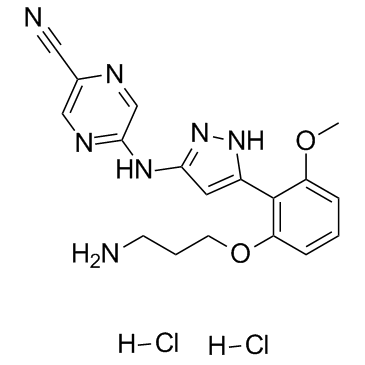Prexasertib dihydrochloride |
| Catalog No.GC36966 |
Prexasertib 이염산염(LY2606368 이염산염)은 Ki가 0.9nM이고 IC50이 1nM 미만인 선택적 ATP 경쟁 2세대 체크포인트 키나제 1(CHK1) 억제제입니다. Prexasertib 이염산염은 CHK2(IC50=8nM) 및 RSK1(IC50=9nM)을 억제합니다. Prexasertib dihydrochloride는 이중 가닥 DNA 파손 및 복제 재앙을 일으켜 세포 사멸을 유발합니다. Prexasertib dihydrochloride는 강력한 항종양 활성을 나타냅니다.
Products are for research use only. Not for human use. We do not sell to patients.

Cas No.: 1234015-54-3
Sample solution is provided at 25 µL, 10mM.
Prexasertib dihydrochloride (LY2606368 dihydrochloride) is a potent and selective ATP competitive inhibitor of the Chk1 protein kinase, with IC50s of <1 nM and 8 nM for CHK1 and CHK2, respectively, and a Ki of 0.9 nM against purified CHK1. Chk1|0.9 nM (Ki)|Chk1|<1 nM (IC50)|Chk2|8 nM (IC50)
Prexasertib (LY2606368) is a potent and selective ATP competitive inhibitor of Chk1, with an IC50 of <1 nM, and also inhibits CHK2, with an IC50 of 8 nM. Prexasertib has an EC50 of 1 nM for CHK1 activity through autophosphorylation of serine 296 and <31 nM for HT-29 CHK2 autophosphorylation (S516). Prexasertib potently abrogates the G2-M checkpoint activated by doxorubicin in p53-deficient HeLa cells with an EC50 of 9 nM. However, 100 nM Prexasertib does not inhibit PMA-stimulated RSK but instead weakly stimulates phosphorylation of S6 on serines 235/236. Prexasertib is broadly antiproliferative with IC50s of 3 nM, 3 nM, 10 nM, 37 nM, and 68 nM against U-2 OS, Calu-6, HT-29, HeLa, and NCI-H460 cell lines, respectively. Prexasertib (4 nM) results in a large shift in cell-cycle populations from G1 and G2-M to S-phase with an accompanied induction of H2AX phosphorylation in U-2 OS cells[1]. Prexasertib (LY2606368; 25 μM) exhibits inhibitory activities against proliferation of AGS and MKN1 cells. Prexasertib (20 nM) inhibits HR repair capacity DR-GFP cells. Prexasertib (5 nM) in combination with PARP inhibitor BMN673, displays synergistic anticancer effects in gastric cancer cells[2].
Prexasertib (LY2606368; 15 mg/kg, s.c.) significantly inhibits tumor growth in xenograft tumor models with less animal weight loss[1]. Prexasertib (LY2606368; 2 mg/kg, s.c.) and BMN673 combination has synergistic anticancer effect in gastric cancer PDX model, and the effect is higher than that of one drug alone[2].
[1]. King C, et al. LY2606368 Causes Replication Catastrophe and Antitumor Effects through CHK1-Dependent Mechanisms. Mol Cancer Ther. 2015 Sep;14(9):2004-1 [2]. Yin Y, et al. Chk1 inhibition potentiates the therapeutic efficacy of PARP inhibitor BMN673 in gastric cancer. Am J Cancer Res. 2017 Mar 1;7(3):473-483.
Average Rating: 5 (Based on Reviews and 37 reference(s) in Google Scholar.)
GLPBIO products are for RESEARCH USE ONLY. Please make sure your review or question is research based.
Required fields are marked with *




















